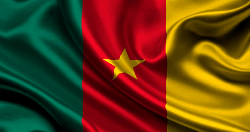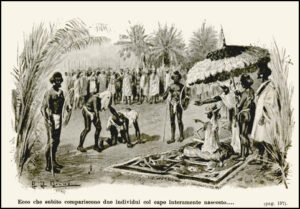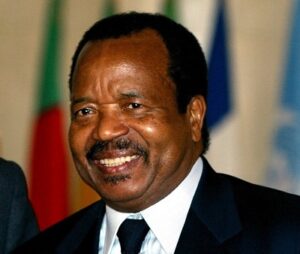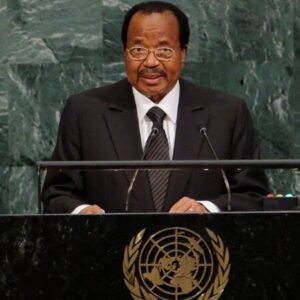CAMEROON, A LAND OF WELCOMING AND OPPORTUNITIES

H.E. Mr. PAUL BIYA
President of the Republic of Cameroon

Presentation

Cameroon is located in Central Africa, in the Gulf of Guinea. It is bordered to the north by Chad, to the east by the Central African Republic, to the south by the Congo, Gabon and Equatorial Guinea, and to the west by Nigeria. Cameroon is a country with a number of major cities, including YAOUNDE, the country’s political capital with over one million inhabitants, and DOUALA, the economic capital with over two million inhabitants. Then we have other towns such as GAROUA, BAFOUSSAM, MAROUA, BAMENDA, BUEA, NGAOUNDERE, EBOLOWA and BERTOUA, which are major urban centres.
Cameroon has 240 ethnic groups, divided into three main groups (Bantu, Semi-Bantu, Sudanese) and 240 national languages. The most representative ethnic groups are:
-Bantous : Béti, Bassa, Bakundu, Maka, Douala, Pygmées.
-Semi-Bantous : Bamiléké, Gbaya, Bamoun, Tikar.
-Soudanais : Foulbé, Mafa, Toupouri, Arabes-Choas, Moundang, Massa, Mousgoum.
THE 10 REGIONS OF CAMEROON
Adamawa Region, Centre Region, East Region, Far North Region, Littoral Region, North Region, North-West Region, West Region, South Region, South-West Region.
History

The first inhabitants of Cameroon were probably the Baka, also known as Pygmies. They still live in the forests of the southern and eastern provinces. In the first millennium BC: the area covering the south-west of present-day Cameroon and the south-east of Nigeria is thought to have been the cradle of the Bantu-speaking peoples. The first historical reference to the coast of Cameroon can be found in the story of Hannon’s voyage, based on a highly controversial Greek text. In 1472, the sailors of the Portuguese Fernando Pó entered the Wouri estuary and were delighted by the abundance of prawns in the river, which they immediately named “Río dos Camarões”. The English sailors adopted this name and anglicised it, hence the current name of Cameroon.
Independence and Reunification
1 January 1960: East Cameroon was declared sovereign and independent. On New Year’s Day 1960, Cameroon became the first country to open the long parade of African independence. Cameroon was then a country apart in every respect. It had been a German protectorate (July 1884), then a League of Nations mandate (July 1919) for France and England to administer Cameroon as two separate territories, and finally a country under UN trusteeship (26 June 1945). 5 May 1960: Ahmadou Ahidjo was elected President of the Republic, with Charles Assalé as Prime Minister. 14 August 1961: Following the Foumban Conference, the Federal Constitution was adopted: Ahmadou Ahidjo became President of the Republic and John Nguh Foncha Vice-President. 1 October 1961: The southern part of British Cameroon became independent and officially joined the Republic of Cameroon, thus creating the Federal Republic of Cameroon. 20 May 1972: Referendum on the reunification of East and West Cameroon. Cameroon became the United Republic of Cameroon.

The Unification
May 20, 1972: Cameroon is declared a United Republic. June 30, 1975: Paul BIYA is appointed Prime Minister of the United Republic of Cameroon. November 4, 1982: Ahmadou Ahidjo unexpectedly resigns from his position as Head of State of the United Republic of Cameroon and asks the Cameroonian people to accept his constitutional successor to the supreme office, in the person of Mr. Paul BIYA, until then Prime Minister. November 6, 1982: Paul BIYA takes the oath and becomes President of the Republic with Bello Bouba Maigari as Prime Minister.
Democratic Opening
05 December 1990: Introduction of a multi-party system. 19 December 1990: Promulgation of a series of laws on public freedoms, paving the way for the total liberalisation of socio-political, economic and cultural life in Cameroon. April 1991: Creation of the post of Prime Minister, Head of Government by parliamentary majority, in accordance with the law on constitutional revision of 23 April 1991. 27 June 1991: 27 June 1991: The main players in the fight for the liberation of Cameroon were elevated to the status of national heroes. 1 March 1992: First pluralist parliamentary elections.
January to May 1996: Clashes between Cameroon and Nigeria over the Bakassi peninsula. The two countries eventually accept UN mediation. 21 January 1996: First pluralist municipal elections.
14 August 2008: Signing of the agreement on the retrocession of the Bakassi peninsula to Cameroon in Calabar, capital of the Nigerian state of Cross River, to which Bakassi belonged. 20 May 2010: Start of the commemorations of the independence and reunification of Cameroon.
Cameroonian diplomacy

As a founding member of the OAU (Organisation of African Unity, which later became the African Union), Cameroon has long based its diplomacy on one of the basic principles of the pan-African organisation: non-interference in the internal affairs of other states.
This particular concern to hold the sovereignty of third countries sacred has sometimes been wrongly perceived as an astonishing “indifference”. In view of Cameroon’s leading position in the Central African sub-region, which is in the throes of constant upheaval.
Aware of the distortion and anxious to forge an image for his country more in keeping with its real potential, President Paul BIYA has embarked on a vigorous campaign to reorient and revitalise Cameroon’s foreign policy. This option has resulted in a remarkable rise in the power of Cameroonian diplomacy, which is generously deployed on all fronts. Starting with the multilateral organisations and institutions with which the country is linked: UN, African Union, Francophonie, Commonwealth, 00, CEMAC, World Bank, etc. Here and there, Cameroon is doing its utmost to make its voice heard, to put forward ideas that will help build a safer and more united international society.
Cameroonian politics

The current institutional and political organisation of the Republic of Cameroon draws its legitimacy and foundations from Law No. 96/06 of 18 January 1996 to revise the Constitution of 2 June 1972. The current constitutional provisions were adopted by the National Assembly and promulgated by the President of the Republic after wide consultation with all sections of Cameroonian society.
The constitutional provisions in force since 18 January 1996 solemnly affirm the characteristic principles of the Republic of Cameroon. It is “a decentralised unitary State. It is one and indivisible, secular, democratic and social”. (Article 1). A multicultural and multilingual State, Cameroon, taking into account its history, adopts English and French as official languages of equal value. The motto of the Republic of Cameroon is: Peace-Work-Fatherland. Article 2 of the Constitution states that “national sovereignty belongs to the Cameroonian people, who exercise it either through the President of the Republic and the members of Parliament, or by referendum”. The authorities responsible for running the State derive their powers from the people through elections by direct or indirect universal suffrage. Voting is equal and secret. The legal voting age is 20 years.

